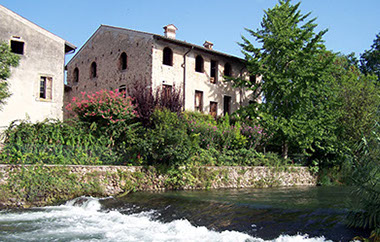Progetto di valorizzazione
del territorio di Valeggio sul Mincio
Corte Regia
VII - VIII SECOLO
Gli abitanti di Borghetto hanno sempre chiamano con l'appellativo di “Corteregia” questo particolare complesso urbano edificato sulla riva destra del Mincio, a lato del luogo dove per secoli è esistito uno dei più importanti punti di attraversamento del corso d’acqua.
Nel VI secolo i Longobardi arrivarono in Italia e Verona fu una delle città cardine della loro espansione nella penisola.
La loro organizzazione amministrativa predispose delle barriere doganali sia nelle principali città, sia nelle zone di confine territoriale più significative.
Questi luoghi governativi di esazione delle gabelle vennero chiamati Curtis Regie.
Una di queste fu realizzata a lato del guado del Mincio per riscuotere i dazi sui traffici fluviali e terrestri che qui si incrociavano. Il fiume segnava in quel tempo il confine fra il ducato longobardo di Brescia e quello di Verona.
Inizialmente, si trattava di un cortile a pianta irregolare, circondato da mura, confinante sul lato orientale con il fiume e su quello meridionale con la strada comune, un fossato circondava gli altri due lati; all’interno c’era una costruzione in muratura di una certa importanza.
La presenza di questa istituzione attirò nella Valle dei coloni che diedero vita a un primo insediamento abitato. La dominazione longobarda è attestata anche dalla toponomastica locale che è sopravvissuta ai secoli.
Ad esempio, i vasti prati che si estendono a nord del Ponte Fortificato Visconteo, sono ancora oggi indicati con il termine “Braida”, che localizzava coltivazioni agricole nei pressi di un villaggio.
Il piccolo centro rivierasco, sorto attorno alla Curtis Regia fra i secoli VII e VIII, si sviluppò lentamente e all'inizio del secondo millennio assunse il nome di Borghetto.
Questo toponimo, mutuato dal termine medievale tedesco Burg, era usato nell'Italia settentrionale del X-XI secolo per individuare comunità rurali giuridicamente costituite o luoghi caratterizzati da apprestamenti militari, come questo insediamento fiscale.
Attorno all’XI secolo, la costruzione di una chiesa e di un piccolo cenobio, sancì definitivamente la nascita del centro urbano di Borghetto.
Corte Regia
ROYAL COURT - 7th - 8th CENTURY
The inhabitants of Borghetto have always given the name of “Corteregia” to this particular space built on the right bank of the Mincio, next to the place where one of the most important river crossing points has existed for centuries.
In the 6th century the Longobards arrived in Italy and Verona became one of the main cities to their expansion in the peninsula.
Their administrative organization created customs barriers, both in the main cities and in the most significant border areas.
These governmental places, where taxes were collected, were called Curtis Regie (Royal Courts).
One of these places was built next to the ford of the Mincio, to collect the levies coming from the vessels and land traffic which arrived in this place.
At the time, the river marked the border between the Longobard duchy of Brescia and that of Verona.
Initially, the structure was composed of an irregular plan courtyard, surrounded by walls, which bordered on the eastern side with the river and on the southern side with the communal road.
A moat surrounded the other sides; in the courtyard, an important masonry structure was erected.
The presence of this customs post attracted some colonists to the valley where they gave life to the first settlement.
The Longobard domination is attested also by the local toponymy which has survived for centuries.
For example, the vast fields extending north of the fortified Visconti Bridge are still today designated with the name “Braida”, a term which located agricultural crops next to a village.
The small river center, built around the Curtis Regia between the 7th and 8th centuries, developed slowly and at the beginning of the second millennium took the name Borghetto.
This toponym was borrowed from the German medieval term Burg, used in northern Italy of the 10th-11th century both to identify legally established rural communities, and those characterized by defensive preparations, such as our fiscal settlement.
Around the eleventh century, the construction near a church and a small monastery definitively sanctioned the birth of this urban center.
Königshof
7.-8. Jhr.
Mittelalterliche Route
Die Bewohner von Borghetto haben diesen besonderen urbanen Bau seit jeher als „Corteregia“ bezeichnet, der an der Stelle am rechten Ufer des Mincios steht, an dem sich über Jahrhunderte eine der wichtigsten Stellen für die Überquerung des Flusses befand.
Als die Langobarden im 6. Jahrhundert nach Italien kamen, wurde Verona zur wichtigsten Stadt für ihre Ausdehnung auf der Halbinsel. Die Organisation ihrer Verwaltung ließ Zollschranken in den wichtigsten Städten und in den bedeutendsten Grenzländern errichten.
Diese Mautstellen, an denen man die Zollabgaben errichtet musste, wurden Curtis Regie genannt. Eine diese Mautstellen wurde an der Seite der Furt des Mincios errichtet, um die Zölle für den hiesigen Fluss- und Landverkehr einzuheben.
Der Fluss zeichnete zu jener Zeit die Grenze zwischen dem langobardischen Herzogtum Brescia und dem von Verona. Anfangs handelte es sich um einen Innenhof von unregelmäßigem Grundriss, der von einer Mauer umgeben war.
Im Osten grenzte er an den Fluss und im Süden an die Gemeindestraße, an den restlichen beiden Seiten befand sich ein Graben. Im Inneren gab es eine beachtliche Mauerkonstruktion.
Wegen der Präsenz dieser Anlage zogen Siedler in das Tal. So entstanden die ersten Ansiedelungen. Die langobardische Herrschaft ist auch in den lokalen Ortsnamen erkennbar, die über Jahrhunderte überlebte.
Die großen Wiesen, die vom Norden der befestigten Visconteo-Brücke wegführen, werden noch heute als “Braida” bezeichnet, einem Begriff, der für landwirtschaftliche Bewirtschaftungen in der Nähe einer Ortschaft benutzt wurde.
Die kleine Ortschaft am Ufer entstand zwischen dem 7. und 8. Jahrhundert um die Curtis Regia und wurde langsam größer. Am Beginn des zweiten Jahrtausends änderte sie ihren Namen in Borghetto. Dieser wurde vom mittelalterlichen deutschen Begriff Burg abgleitet, der im 10. und 11. Jahrhundert in Norditalien gebräuchlich war, um ländliche Gemeinschaften oder Ortschaften zu bezeichnen, die für militärische Vorbereitungen dienten, wie diese Ansiedlung, die zur Steuereintreibung diente.
Der Bau einer Kirche und eines kleinen Klosters um das 11. Jahrhundert führt endgültig zur Entstehung des Stadtzentrums von Borghetto.



© 2019
Comune di Valeggio sul Mincio (VR)
Associazione Percorsi


